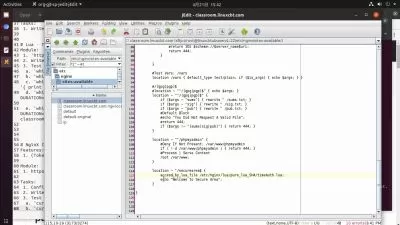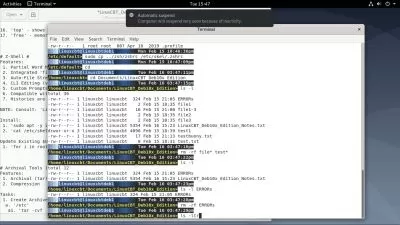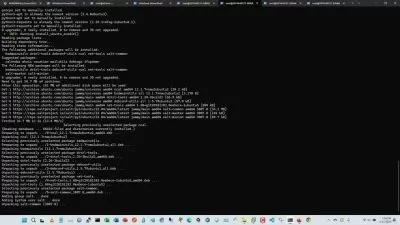Linux Administration Bootcamp: Go from Beginner to Advanced
Jason Cannon
8:59:47
Description
Learn Red Hat Linux & CentOS: Use the in-demand skills to start a career as a Linux Server Admin or Linux Administrator!
What You'll Learn?
- By the end of this course you will understand the fundamentals of the Linux operating system and be able to apply that knowledge in a practical and useful manner.
Who is this for?
What You Need to Know?
More details
DescriptionJOIN THE OTHER 20,000 SUCCESSFUL STUDENTS WHO HAVE ALREADY MASTERED THE LINUX OPERATING SYSTEM WITH ONE OF MY TOP RATED COURSES!
If you want to learn Linux system administration and supercharge your career, read on.
Hello. My name is Jason Cannon and I'm the author of Linux for Beginners, the founder of the Linux Training Academy, and an instructor to thousands of satisfied students. I started my IT career in the late 1990's as a Unix and Linux Systems Engineer and I'll be sharing my real-world Linux experience with you throughout this course.
By the end of this course you will fully understand the most important and fundamental concepts of Linux server administration. More importantly, you will be able to put those concepts to use in practical real-world situations. You'll be able to configure, maintain, and support a variety of Linux systems. You can even use the skills you learned to become a Linux System Engineer or Linux System Administrator.
Free Bonus - Video Demonstrations from my best-selling book, Command Line Kung-Fu.
In this series of videos I'll be sharing with you some of my favorite Linux command line tricks. These tips will make your life easier at the command line, speed up your work flow, and make you feel like a certified Linux command line Ninja! If you want to see the pages of Command Line Kung-Fu come to life, then you have to watch these videos!
____________________
This Linux course doesn't make any assumptions about your background or knowledge of Linux. You need no prior knowledge to benefit from this course. You will be guided step by step using a logical and systematic approach. As new concepts, commands, or jargon are encountered they are explained in plain language, making it easy for anyone to understand. Here is what you will learn by taking Linux Bootcamp:
- How to get access to a Linux server if you don't already.
- What a Linux distribution is and which one to choose.
- What software is needed to connect to Linux from Mac and Windows computers.
- What SSH is and how to use it.
- The file system layout of Linux systems and where to find programs, configurations, and documentation.
- The basic Linux commands you'll use most often.
- Creating, renaming, moving, and deleting directories.
- Listing, reading, creating, editing, copying, and deleting files.
- Exactly how permissions work and how to decipher the most cryptic Linux permissions with ease.
- How to use the nano, vi, and emacs editors.
- Two methods to search for files and directories.
- How to compare the contents of files.
- What pipes are, why they are useful, and how to use them.
- How to compress files to save space and make transferring data easy.
- How and why to redirect input and output from applications.
- How to customize your shell prompt.
- How to be efficient at the command line by using aliases, tab completion, and your shell history.
- How to schedule and automate jobs using cron.
- How to switch users and run processes as others.
- How to find and install software.
- How the the boot process works on Linux servers and what you can do to control it.
- The various types of messages generated by a Linux system, where they're stored, and how to automatically prevent them from filling up your disks.
- Disk management, partitioning, and file system creation.
- Logical Volume Manager (LVM) - extending disk space without downtime, migrating data from one storage to another, and more.
- Managing Linux users and groups.
- Networking concepts that apply to system administration and specifically how to configure Linux network interfaces.
- How to configure sudo.
- Managing process and jobs.
- Linux shell scripting
- Unconditional Udemy 30 day money-back guarantee - that's my personal promise of your success!
What you learn in Linux Bootcamp applies to any Linux environment including CentOS, Ubuntu, Debian, Kali Linux, Linux Mint, RedHat Linux, Fedora, OpenSUSE, Slackware, and more.
Enroll now and start learning the skills you need to level up your career!
Who this course is for:
- People with limited time.
- Anyone with a desire to learn about Linux.
- People that have Linux experience, but would like to learn about the Linux command line interface.
- Existing Linux users that want to become power users.
- People that need Linux knowledge for a personal or business project like hosting a website on a Linux server.
- Professionals that need to learn Linux to become more effective at work. Helpdesk staff, application support engineers, and application developers that are required to use the Linux operating system.
- People thinking about a career as a Linux system administrator or engineer, but need the basics first.
- Researchers, college professors, and college students that will be using Linux servers to conduct research or complete course work.
JOIN THE OTHER 20,000 SUCCESSFUL STUDENTS WHO HAVE ALREADY MASTERED THE LINUX OPERATING SYSTEM WITH ONE OF MY TOP RATED COURSES!
If you want to learn Linux system administration and supercharge your career, read on.
Hello. My name is Jason Cannon and I'm the author of Linux for Beginners, the founder of the Linux Training Academy, and an instructor to thousands of satisfied students. I started my IT career in the late 1990's as a Unix and Linux Systems Engineer and I'll be sharing my real-world Linux experience with you throughout this course.
By the end of this course you will fully understand the most important and fundamental concepts of Linux server administration. More importantly, you will be able to put those concepts to use in practical real-world situations. You'll be able to configure, maintain, and support a variety of Linux systems. You can even use the skills you learned to become a Linux System Engineer or Linux System Administrator.
Free Bonus - Video Demonstrations from my best-selling book, Command Line Kung-Fu.
In this series of videos I'll be sharing with you some of my favorite Linux command line tricks. These tips will make your life easier at the command line, speed up your work flow, and make you feel like a certified Linux command line Ninja! If you want to see the pages of Command Line Kung-Fu come to life, then you have to watch these videos!
____________________
This Linux course doesn't make any assumptions about your background or knowledge of Linux. You need no prior knowledge to benefit from this course. You will be guided step by step using a logical and systematic approach. As new concepts, commands, or jargon are encountered they are explained in plain language, making it easy for anyone to understand. Here is what you will learn by taking Linux Bootcamp:
- How to get access to a Linux server if you don't already.
- What a Linux distribution is and which one to choose.
- What software is needed to connect to Linux from Mac and Windows computers.
- What SSH is and how to use it.
- The file system layout of Linux systems and where to find programs, configurations, and documentation.
- The basic Linux commands you'll use most often.
- Creating, renaming, moving, and deleting directories.
- Listing, reading, creating, editing, copying, and deleting files.
- Exactly how permissions work and how to decipher the most cryptic Linux permissions with ease.
- How to use the nano, vi, and emacs editors.
- Two methods to search for files and directories.
- How to compare the contents of files.
- What pipes are, why they are useful, and how to use them.
- How to compress files to save space and make transferring data easy.
- How and why to redirect input and output from applications.
- How to customize your shell prompt.
- How to be efficient at the command line by using aliases, tab completion, and your shell history.
- How to schedule and automate jobs using cron.
- How to switch users and run processes as others.
- How to find and install software.
- How the the boot process works on Linux servers and what you can do to control it.
- The various types of messages generated by a Linux system, where they're stored, and how to automatically prevent them from filling up your disks.
- Disk management, partitioning, and file system creation.
- Logical Volume Manager (LVM) - extending disk space without downtime, migrating data from one storage to another, and more.
- Managing Linux users and groups.
- Networking concepts that apply to system administration and specifically how to configure Linux network interfaces.
- How to configure sudo.
- Managing process and jobs.
- Linux shell scripting
- Unconditional Udemy 30 day money-back guarantee - that's my personal promise of your success!
What you learn in Linux Bootcamp applies to any Linux environment including CentOS, Ubuntu, Debian, Kali Linux, Linux Mint, RedHat Linux, Fedora, OpenSUSE, Slackware, and more.
Enroll now and start learning the skills you need to level up your career!
Who this course is for:
- People with limited time.
- Anyone with a desire to learn about Linux.
- People that have Linux experience, but would like to learn about the Linux command line interface.
- Existing Linux users that want to become power users.
- People that need Linux knowledge for a personal or business project like hosting a website on a Linux server.
- Professionals that need to learn Linux to become more effective at work. Helpdesk staff, application support engineers, and application developers that are required to use the Linux operating system.
- People thinking about a career as a Linux system administrator or engineer, but need the basics first.
- Researchers, college professors, and college students that will be using Linux servers to conduct research or complete course work.
User Reviews
Rating
Jason Cannon
Instructor's Courses
Udemy
View courses Udemy- language english
- Training sessions 74
- duration 8:59:47
- Release Date 2022/12/03








